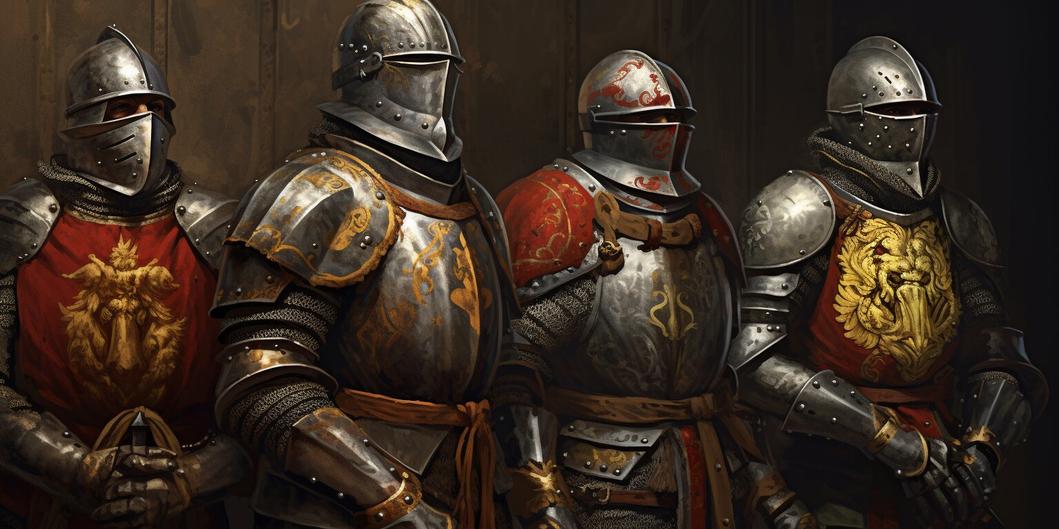There are few known examples of medieval war-hammers or mauls without spikes or blades, especially in the later Middle Ages when plate armor advanced significantly. Earlier medieval weapons, from around AD 500 to 1100, occasionally featured purely blunt designs, but these were less effective against armor and less commonly seen on the battlefield.

War-hammers and mauls evolved largely in response to the development of plate armor. The blunt force of earlier war-hammers could dent or crush armor but often failed to cause lethal damage through the heavy metal plates. To address this, spikes and blades became common additions, focusing impact on small points to penetrate or fracture the armor. Thus, spike-less war-hammers became rare as armor improved.
Early medieval weaponry often favored swords, axes, and maces over war-hammers and mauls. The latter were considered cumbersome and usually required two hands to wield effectively without spikes, limiting their use among troops who typically carried shields. Organized armies preferred versatile and faster weapons for drills and close combat, further reducing the presence of spike-less war-hammers in records.

One notable close example is the stake mallet used by English longbowmen during the Hundred Years’ War, particularly at the Battle of Agincourt in 1415. These mallets, not designed primarily as weapons, were used in close combat after archers exhausted their arrows. While similar to blunt hammers, they were makeshift weapons rather than purpose-crafted war-hammers.
| Era | Weapon Characteristics | Use in Battle |
|---|---|---|
| Early Medieval (AD 500–1100) | Occasionally spike-less blunt war-hammers, simple construction | Limited use, less effective vs. armor, rare |
| Late Medieval to Renaissance | War-hammers typically feature spikes or blades | Designed to penetrate plate armor, common in specialized contexts |
| Hundred Years’ War (1415) | Stake mallets used by archers as last-resort blunt weapons | Makeshift use after arrows spent, not formal war-hammers |
In summary:

- Purely blunt war-hammers without spikes were uncommon and mostly limited to early medieval periods.
- Spikes and blades became standard as armor advanced, increasing penetration capability.
- War-hammers and mauls were generally less favored than swords, axes, and maces.
- Stake mallets provide a notable example of blunt implements repurposed as weapons.
Are There Any Known Examples of a Medieval War-Hammer or Maul That Don’t Have a Spike or Blade?
Yes—there are known examples, especially from the earlier medieval period, where war-hammers and mauls lacked spikes or blades. However, they were less common and often overshadowed by other weapons designed for the evolving demands of warfare.

This question might surprise some, given how iconic the spike or blade on a war-hammer has become in popular culture and historical depictions. But the reality is more nuanced and offers a fascinating glimpse into how medieval weapons evolved alongside armor.
Early Medieval Era: Simplicity Before Complexity

In the period roughly between AD 500 and AD 1100, we see several simple war-hammers and mauls that do not feature spikes or blades. This era predates the widespread use of heavy plate armor. Without thick plates protecting knights, blunt trauma from a straightforward hammer or maul could be devastating enough to incapacitate enemies. In these early centuries, the design of weapons focused on delivering crushing blows rather than piercing armor.
Why avoid spikes? Because there simply was less need for them. Chainmail and leather armor, common during this era, didn’t require piercing to be overcome. A heavy, well-swung maul could break bones or juggle a foe without adding the complexity of a spike. These weapons might not have been flashy or ornate, but they did the job.

Why Did Spikes Become the Norm? Let’s Set Some Context.
By the late medieval and Renaissance eras, plate armor had improved dramatically. The sleek, angled steel resisted smashing blows, making traditional blunt weapons less effective. Enter the spike. The spike allowed warriors to focus their strike on a small area, enough to puncture armor plates or find the gaps between them, potentially causing fatal blows.

So, the spike wasn’t just decoration—it was a smart adaptation to keep war-hammers relevant on the battlefield. Without it, a hammer’s crushing force would bounce off like a pinball against the resilient metal shells surrounding knights.
Were War-Hammers Without Spikes Wielded Often?
Turns out, not really.
War-hammers and mauls weren’t very common in early to high medieval warfare (circa AD 500–1300). Part of the reason is practical: these weapons were heavy and often required two hands for effective use if they lacked spikes. That made wielding a shield alongside them difficult, a tactical disadvantage at a time when shields were a primary defense.
Additionally, other weapons like maces, axes, halberds, and bills were better suited to the needs of foot soldiers and knights. They combined offensive power with relative ease of use, making them preferred choices.
Interestingly, historical records—especially from Byzantine sources—rarely mention war-hammers at all during this vast medieval span. This absence suggests that the war-hammer, particularly the non-spiked variety, wasn’t a favored frontline weapon.
The Italian Connection: A Spark of Innovation
The Italian maritime states such as Venice and Genoa started using spiked war-hammers more extensively starting around 1250. These states were innovators in arms and armor, and their shock troops benefitted from weapons that could crack plate armor.
This Italian use helped spur the spread of spiked war-hammers across Western Europe by the 1400s. By then, spikeless war-hammers were mostly outclassed by their spiked cousins, which were more adaptable to the armor trends of the time.
When Tools Became Weapons: The Case of the Stake Mallet
Here’s an interesting twist. During the Hundred Years’ War, English longbowmen carried wooden stake mallets primarily as tools—not weapons. Yet, in dire moments, these mallets were wielded as crude but effective blunt instruments in melee combat.
Take the Battle of Agincourt in 1415. Once the archers exhausted their arrows, they reportedly used these mallets to fend off armored French men-at-arms crossing the treacherous muddy fields. This shows that even simple wooden mallets could serve as last-resort weapons.
Still, these mallets were not considered war-hammers in the traditional sense. They were makeshift choices rather than purpose-built arms designed for the battlefield’s rigors.
Summing It Up: The Shape of Medieval War-Hammers Without Spikes
So, are there examples of spikeless war-hammers or mauls? Definitely, especially from the early medieval era before plate armor made them obsolete.
But such spikeless designs were rare once armor technology advanced. The two-handed nature, limited tactical advantage, and the rise of better weapon choices pushed spikeless war-hammers to the sidelines.
If you want to spot one, look for early medieval artifacts or illustrations, keep in mind the context of armor types, and remember that sometimes, battlefield practicality outshines flashy design.
What Can Modern Enthusiasts Learn?
- Don’t assume all war-hammers must have spikes. Context matters.
- Armor and offensive tech evolve together. Weapon design reflects this arms race.
- Sledgehammers and mallets were viable, but often last-ditch tools, not standard weapons.
Next time you see a war-hammer in movies or games, pause to imagine its historical cousins: simple, blunt, and spike-free, swinging through a time when crushing force was the king of battlefield damage.
Curious to know more about the evolution of medieval weaponry? Dive deeper into early medieval manuals and surviving museum pieces—they offer a front-row seat to the fascinating story of human conflict and ingenuity.




